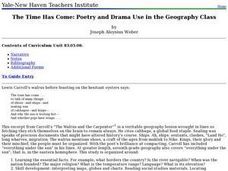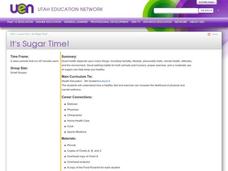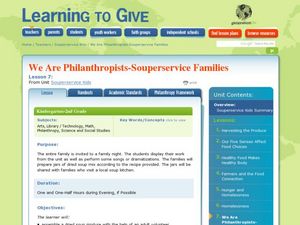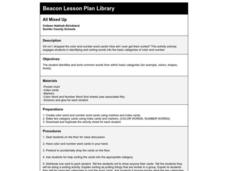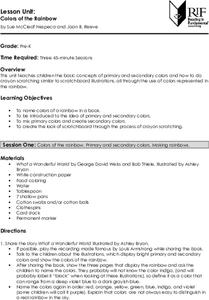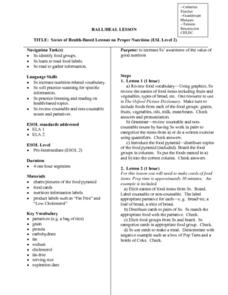Curated OER
What is Cacao?
Students use the Internet to learn about the cacao plant. For this plants lesson, students complete a KWL chart on chocolate, learn about cocoa plants and discuss the parts of a plant. Students use the Internet to learn how...
Curated OER
American Indians and Their Environment
Learners create a storyboard of the three American Indian language groups showing the geography of where they lived and how they adapted to the environment. They compare European and American Indian views of nature and explain how these...
Curated OER
The Plymouth Colony
Third graders discuss the book on the pilgrims. They write a poem of the hardships of the boat or on the land. Students write journal entries as a pilgrim on boat or on the land. They complete a collage of the foods that the pilgrims...
Curated OER
Eagle Boy: A Pacific Northwest Native Tale
Students read the story of the Eagle Boy. For this Native American Tale lesson, students discover the respect a boy has for wildlife. Students discuss eagles and what they symbolize. Students create song lyrics for the story and...
Curated OER
The Time Has Come: Poetry and Drama Use in the Geography Class
Middle schoolers use drama and poetry in their Geography class. In groups, they role play an interviewer or the interviewee in various plays that were presented to them. In their role, they must locate and label where the countries...
Curated OER
What Does The Heart Do?
Students study the relationship between the heart and circulation. In this circulatory system lesson, students read the "What Am I?" article about the heart and discuss. Students draw a heart and lungs, discover how blood is pumped...
Curated OER
Action and Linking Verbs
In this recognizing action verbs and linking verbs in sentences worksheet, students read statements, identify the verbs, and label them either action or linking verbs. Students write 15 answers.
Curated OER
No Title
First graders listen as the book, "Tops and Bottoms," by Janet Stevens is read to them and then participate in a discussion about foods and where they grow. They draw a picture of a plant labeling the major parts of it sequential order.
Curated OER
Candy Bar Fractions
Students explore the relationship between caloric expenditure and exercise, and see a real world use for fractions as they relate to daily life.
Curated OER
Yo! Gert-making yogurt
Young scientists or chefs culture yeast to produce yogurt. The materials and a general description of how make yogurt are provided, but there is very little detail otherwise. You could use this as an activity when your biology class is...
Curated OER
Deep or Shallow
Third graders practice answering questions to aid in creating meaning when reading. Through guided practice, they read a passage from a chapter book and answer in-text and inference questions. Independently, they read another chapter...
Curated OER
Sunny or Shady?
Pupils practice answering questions to aid in creating meaning when reading. Through guided practice, they read a passage from the chapter book "Tuck Everlasting" and answer in-text and inference questions. Independently, they read...
Curated OER
Pour Some
Students compare their desired portions with the actual serving size. In this lesson on serving size, students compare their desired portion of a given food with the actual serving size listed on the Nutritional Facts label.
Curated OER
It's Sugar Time!
Fifth graders examine how good health depends upon many things, including heredity, lifestyle, personality traits, mental health, attitudes, and the environment.
Curated OER
Phonemic Awareness: Pronunciation of /ng/ Consonants
Students practice cononant sounds within reading passages. They articulate the /ng/ sounds and identify their placement in words. Working with a partner, they read a passage aloud and listen for correct pronunciation of sounds.
Curated OER
Starvation in the Ghettos
Learners consider the lack of nutrition experienced in Holocaust ghettos. In this Holocaust lesson, students investigate the Nazi policy of starving people out of the ghettos through their food rationing program. Learners compare Nazi...
Curated OER
Catch Me If You Can: Over and Under
Students read a story. In this vocabulary skills lesson plan, students read The Gingerbread Man, use flannel cut outs to re-enact the gingerbread man running over and under.
Curated OER
We Are Philanthropists- Soup service Families
Students complete a service project. In this philanthropy lesson, students gather with their families to discuss how they can give to others. Students and their families prepare jars of dried soup mix that will be distributed to local...
Curated OER
It's a Wrap!
Students read about the importance of packaging foods and related items properly and reducing waste. In this packaging lesson, students read the background information about packaging and bring a variety of packaging materials to class....
Curated OER
Elements of Design
High schoolers define basic design vocabulary. They examine fabrics and sort into similar piles, design a picture of a beautiful room and label each art element in the design. They read an article from an interior design magazine and...
Curated OER
All Mixed Up
Students identify and sort words into the basic categories of color and number. After a lecture/demo, students utilize a worksheet imbedded in this plan to gain practice sorting number words.
Curated OER
Colors of the Rainbow
Students explore primary and secondary colors through the use of colors represented in the rainbow. They read and discuss the book, 'What a Wonderful World,' mix paint colors and paint rainbows, and create scratchboard paintings.
Curated OER
Hall/ Heal Lesson
Students review the food groups and vocabulary in order to define how good nutrition is part of good health. They read a variety of articles in order to better understand the concept and develop reading comprehension at the same time.
Curated OER
Observing Pods
Students observe the pistil growing into a tiny string bean-like seed pod. They then observe the development of the fertilized pods between Day 17 and Day 35 and record their observations by drawing and labeling, writing, and graphing. ...




